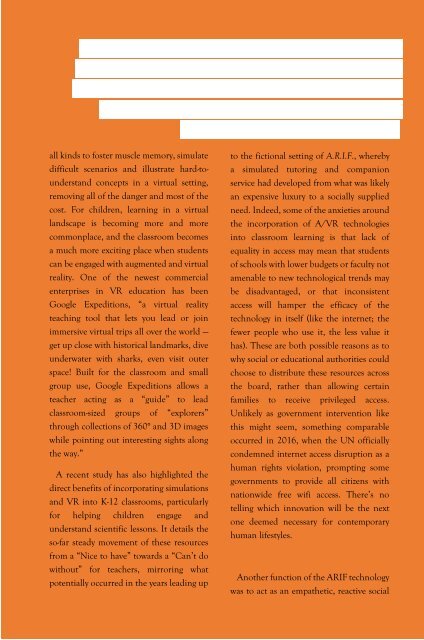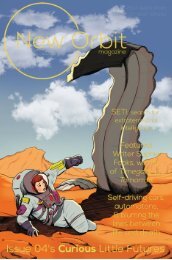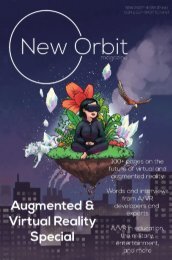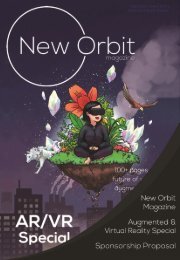Feb 2018 v01 online
((Incomplete formatting))
((Incomplete formatting))
Create successful ePaper yourself
Turn your PDF publications into a flip-book with our unique Google optimized e-Paper software.
all kinds to foster muscle memory, simulate<br />
difficult scenarios and illustrate hard-tounderstand<br />
concepts in a virtual setting,<br />
removing all of the danger and most of the<br />
cost. For children, learning in a virtual<br />
landscape is becoming more and more<br />
commonplace, and the classroom becomes<br />
a much more exciting place when students<br />
can be engaged with augmented and virtual<br />
reality. One of the newest commercial<br />
enterprises in VR education has been<br />
Google Expeditions, “a virtual reality<br />
teaching tool that lets you lead or join<br />
immersive virtual trips all over the world —<br />
get up close with historical landmarks, dive<br />
underwater with sharks, even visit outer<br />
space! Built for the classroom and small<br />
group use, Google Expeditions allows a<br />
teacher acting as a “guide” to lead<br />
classroom-sized groups of “explorers”<br />
through collections of 360° and 3D images<br />
while pointing out interesting sights along<br />
the way.”<br />
A recent study has also highlighted the<br />
direct benefits of incorporating simulations<br />
and VR into K-12 classrooms, particularly<br />
for helping children engage and<br />
understand scientific lessons. It details the<br />
so-far steady movement of these resources<br />
from a “Nice to have” towards a “Can’t do<br />
without” for teachers, mirroring what<br />
potentially occurred in the years leading up<br />
to the fictional setting of A.R.I.F., whereby<br />
a simulated tutoring and companion<br />
service had developed from what was likely<br />
an expensive luxury to a socially supplied<br />
need. Indeed, some of the anxieties around<br />
the incorporation of A/VR technologies<br />
into classroom learning is that lack of<br />
equality in access may mean that students<br />
of schools with lower budgets or faculty not<br />
amenable to new technological trends may<br />
be disadvantaged, or that inconsistent<br />
access will hamper the efficacy of the<br />
technology in itself (like the internet; the<br />
fewer people who use it, the less value it<br />
has). These are both possible reasons as to<br />
why social or educational authorities could<br />
choose to distribute these resources across<br />
the board, rather than allowing certain<br />
families to receive privileged access.<br />
Unlikely as government intervention like<br />
this might seem, something comparable<br />
occurred in 2016, when the UN officially<br />
condemned internet access disruption as a<br />
human rights violation, prompting some<br />
governments to provide all citizens with<br />
nationwide free wifi access. There’s no<br />
telling which innovation will be the next<br />
one deemed necessary for contemporary<br />
human lifestyles.<br />
Another function of the ARIF technology<br />
was to act as an empathetic, reactive social










